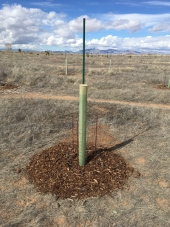My family has been consistently throwing away one 50 gallon trash can per person per year since the 1990’s. When weekly trash pick up came to the neighborhood, we never bothered to sign up. It wasn’t a struggle, and we didn’t think about it much or give things up in order to reduce our trash production. We only noticed that it was kind of a big deal after a decade of watching the neighbors put their bins out every week and wondering what the heck they put in there?!
Here’s how it works:
1. Build your soil - mulch, compost, tera preta, whatever, if it rots and it’s not a piece of an animal, make it back into dirt using a method that works for you and your environment. (tera preta and bokashi may make meat/bones ok, do your homework.) When I moved away from my parents’ property (zone 8, 35” rain/year) to my place (Zone 6, 10” rain/year) I had to change methods, and my trash production spiked while I figured it out.
2. Burn your burnables - be careful here, know what you’re burning so you don’t mess up your chimney or make ash with toxic gick in it. Outdoor fire pits/covered cauldrons/rocket mass pizza ovens can work if you have a yard but not a fireplace/woodstove/rmh in your house. Bonus points if you heat your house with your RMH this way. Use the ash on property (in the garden, soap, etc.) Alternately, shred and compost your burnables, but again, do your homework and listen to Paul’s discussions of toxins in paper products and cardboard.
3. Repurpose/Recycle - see the better world book on this, and do your homework. Not all recyclables actually get recycled. Give away stuff that is still serviceable rather than throwing it away, but be real about what’s still “serviceable”, or whether you’re actually going to make that rag rug with all those worn out shirts.
4. Pre-cycle: Buy in bulk (less packaging) infrequently (less purchasing), buy good quality stuff, take care of it, and repair it when it breaks. This works for us because we have the option to have dedicated pantry rooms and large attics in our houses.
That’s it. In hindsight, we could probably cut our trash in half if we made Sepp Holzer’s bone sauce with the meat and bone scraps. The only thing left would be random bits of plastic wrap and blister packaging.









